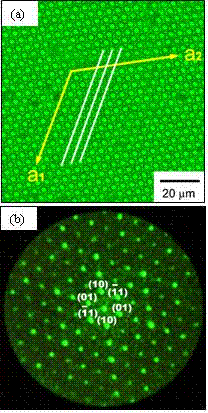

45637-AC5
Fabrication of Nano/Microstructured Organic Films using Breath Figures
Breath figures form on cold solid or liquid substrates in contact with
moist air. On the liquid substrates, at low droplet coverage, nearly monodisperse size drops are able to self organize as rafts
and these rafts then assemble in patterns that are similar to two-dimensional
crystals full of defects. Breath figure like patterns appear on evaporating
polymer solution, exposed to a blast of moist air. While on both solid and
liquid substrates the latter stages in droplet growth are dominated by
coalescence, in experiments done with polymer solutions, one is able to observe
a highly ordered assembly of non-coalescing drops. These non-coalescing
droplets eventually evaporate away leaving a film full of pores. The water
droplets are usually monodisperse in size and can
pack to the surface coverage approaching 0.90. In this study we elucidate the
mechanism by which water drops nucleate, grow and assemble, the role played by
solvent choice as well as humidity and speed of the blast of moist air and
provide a theoretical framework which allows us to quantify the effect of these
parameters on final assembly.
In an
optical microscope, when well-collimated light is normally incident onto a
sample in the transmitted mode, light will be transmitted in different
directions with certain amplitude transmission function depending on the
optical properties of the sample. Light waves leaving the sample film in the
propagation direction are focused by an objective to a point in its back focal
plane and interfere. All of the focused points form a diffraction pattern in
the back focal plane with the position of each point corresponding to a
diffraction angle (angle between the diffracted beam and the incident beam).
For Gaussian optics (i.e., small angle or paraxial approximation), the
relationship of the diffraction-point position and the sinusoid of the
diffraction angle is linear. In a modern optical microscope, a series of lenses
are combined to make a complex objective so that the linear approximation can be
preserved out to large angles (up to the angular semi-aperture of the
objective). As shown in
Fig. 1, the microporous film gives very nice, neat
spot diffraction pattern with six-fold modulation, which is evident of the
hexagonal order of the micropore
array. Average spacing of the pores can be calculated from the diffraction
pattern by two-dimensional Bragg's law, also called grating equation. Bragg's law for transmission through a
two-dimensional lattice is ml = n dhk sin In the past year we have performed
experiments to figure out if the model that we proposed is accurate, and we
have also characterized the holey films using imaging in both real space and in
Fourier space – we describe briefly the progress made in characterizing these
films.
In the past year we have performed
experiments to figure out if the model that we proposed is accurate, and we
have also characterized the holey films using imaging in both real space and in
Fourier space – we describe briefly the progress made in characterizing these
films.
where, m is the order of the diffraction maximum (m = 0, 1, 2, ¼), l is the wavelength of the incident light, n is the refractive index of the dispersion medium, dhk is the lattice spacing and q is the angle between the incident and diffracted beams.
A way to qualitatively check the sixfold order is to look at the coordination number (z) of every pore and the fraction (Pz) of the pores that exhibit a given coordination z. The coordination number (z) of a pore is the number of its nearest neighbors. For a perfect hexagonal lattice, all the pores should have six neighbors and P6 should be one.
In order to determine which pores are neighbors, we use a method based on Voronoi polygons. Voronoi polygon is defined as the smallest convex polygon surrounding a point whose sides are the bisectors of the lines between the point and its neighbors.
Further, the degree of order in a system can be described in terms of the entropy of conformation, defined as S = - S Pz lnPz. The smaller the value of S is, the higher the degree of order is. We can see, in our films, most polygons are six-sided (P6 is larger than 0.9), while only a small amount of polygons have five and seven sides, and other polygons are almost nonexistent. To further quantitatively characterize the degree of the order of our hexagonally structured microporous films, we used the bond-orientational correlation function, G6(r). Results of these studies are detailed in a publication submitted recently to Soft Matter.
We have also used the breath figure templated structures to mimic the optics found on the wingscales of a butterfly, Papilio palinurus.
This research support has been valuable to my students and my group. Some of the work was performed by my student Matija Crne who continues to work on problems related to thin films in nature.